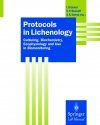Handbook / Manual
Edited By: I Kranner, R Beckett and A Varma
580 pages, 88 Figs, 4 col figs, tabs
![Protocols in Lichenology Protocols in Lichenology]()
Click to have a closer look
About this book
Contents
Customer reviews
Related titles
About this book
As an intricate association between a fungus and one or more green algae or cyanobacteria, lichens are one of the most successful examples of symbiosis. These fascinating organisms survive extreme desiccation and temperatures. They are adapted to a great variety of habitats, from deserts to intertidal zones, from tropical rain forests to the peaks of the Himalayas and to circumpolar ecosystems. Lichens are extremely efficient accumulators of atmospherically deposited pollutants, and are therefore widely used to monitor environmental pollution. Their wide range of secondary products show pharmaceutically interesting fungicidal, antibacterial and antiviral properties. Lichens are extremely difficult to culture. This manual provides well-tested tissue culture protocols, protocols for studying lichen ultrastructure, (eco)physiology, primary and secondary compounds, and for using lichens as bioindicators.
Contents
Culture and Cultivation.- Ultrastructure.- Physiology and Ecophysiology.- Lichen Compounds.- Nucleic Acids.- Bioindication and Biomonitoring.- Biodiversity and Information Systems.- Glossary.
Customer Reviews
Handbook / Manual
Edited By: I Kranner, R Beckett and A Varma
580 pages, 88 Figs, 4 col figs, tabs
From the reviews: "The aim of the reviewed book is to facilitate the experimental study of lichens by providing detail protocols of analytical methods well-tested in specialised laboratories. ! Each chapter of the book is accompanied by a list of important references. An attached glossary of morphological terms and subject index are also helpful for a potential user. The reviewed book represents an invaluable and unique collection of the most recent methodical approaches to the experimental study of lichens ! ." (J. Gloser, Photosynthetica, Vol. 40 (3), 2002) "This compendium of techniques for handling lichens experimentally is a useful reference for both research and teaching. ! this volume also includes many helpful little tricks that do not usually appear in published research papers, as well as designs for practical devices ! . The book ends with an interesting collection of contributions related to the handling of specimens and data, along with a chapter by V. Wirth on lichen photography. This volume is really a functional working manual." (Dianne Fahselt, The Lichenologist, Vol. 34 (3), 2002) "This practical guide pulls together a corpus of useful methodological material from a wide variety of sources. Thirty-two chapters, contributed by specialists in their fields, provide detailed descriptions of or more protocols necessary for the experimental lichenologist. ! the volume under review contains a wealth of practical advice (in terms of materials, procedures and trouble-shooting, often supported by extensive lists of references), some of which will have wider relevance beyond the lichenologist's requirements." (The Naturalist, 2002) "This is a welcome addition to the series because lichenological methods are seldom documented in texts on mycology, phycology or plant science. Methods described are wide ranging, most are lab procedures, but some are field-based ! . Instructions are more explicit than is usually in a research paper, and include useful tips, warnings of potential pitfalls, and sections on troubleshooting. ! this pleasingly produced volume is a creditable starting point. It is essential buying for lichenologists and deserves a place in institutional libraries ! ." (Peter Crittenden, Microbiology Today, Vol. 29, August, 2002)























![Veldgids Korstmossen [Field Guide to Lichens]](http://mediacdn.nhbs.com/jackets/jackets_resizer_medium/25/259434.jpg?height=150&width=101)











